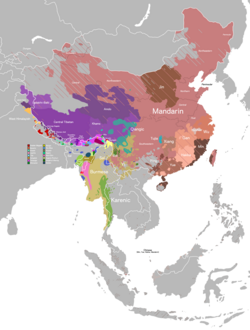| Kachari | |
|---|---|
| কছাৰী | |
| Region | Assam, India |
Native speakers | 16,000 (2011) [1] |
| Language codes | |
| ISO 639-3 | xac |
| Glottolog | kach1279 |
| ELP | Kachari |

Kachari is a Sino-Tibetan language of the Boro-Garo branch that is spoken in Assam, India. With fewer than 60,000 speakers recorded in 1997, and the Asam 2001 Census reporting a literacy rate of 81% the Kachari language is currently ranked as threatened. [3] Kachari is closely related to surrounding languages, including Tiwa, Rābhā, Kochi and Mechi. [4]
Contents
- Division
- Phonology
- Consonants
- Vowels
- Prosody
- Grammar
- Syntax
- Tense
- Adjectives
- Morphology
- Number System
- References
- Bibliography
While there are still living adult speakers, many children are not learning Kachari as their primary language, instead being assimilated into the wider Assamese speaking communities. [5]
